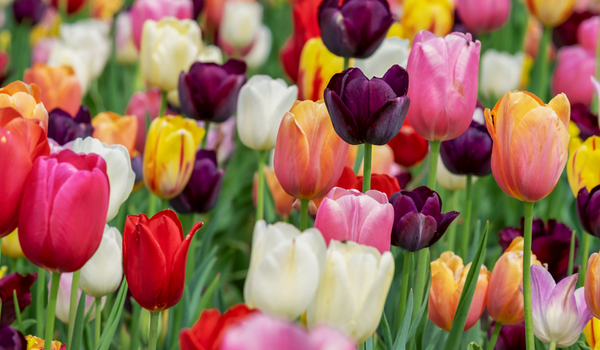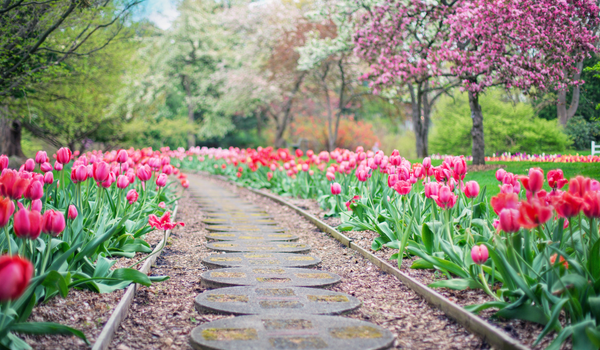How to grow Tulips? - The ultimate growing guide for Tulips
Tulips, with their vibrant colors and elegant blossoms, are a beloved addition to gardens worldwide. These springtime flowers bring a beauty that signals the end of winter's chill and the promise of warmer days ahead. Whether you're a seasoned gardener or a beginner, learning how to grow tulips properly will ensure a breathtaking bloom each year. From growing tulips from bulbs to cultivating and raising them successfully, this guide will walk you through the essential steps to achieve a stunning tulip garden. By the end of this article, you'll be equipped with the knowledge to grow stunning tulips.
So, roll up your sleeves, grab your gardening tools, and let's embark on a journey to unlock the secrets of growing tulips, one petal at a time.
Tulip care tips: ensuring vibrant blooms
To ensure your blooming Tulips thrive and maintain their vibrant beauty, plant them in well-draining soil in a sunny spot during the fall, ideally six to eight weeks before the first frost. Plant the bulbs about 4-6 inches deep with the pointed end facing upwards, and space them a few inches apart. Regularly water them, keeping the soil consistently moist but not waterlogged. Applying a balanced, slow-release fertilizer in early spring can boost their growth. Deadhead faded flowers to encourage more blooms and allow the foliage to wither naturally, as it provides essential nutrients for next year's growth.
Please note that the specific care requirements for Tulips may vary depending on your region and the Tulip variety, so it's essential to consider local conditions and the particular type of Tulips you're growing for the best results. For a stunning spring display, make sure to order tulip bulbs from our collection of premium-quality varieties.

The best time to grow Tulips
Tulips have a specific growing season; they remain dormant during the winter and begin to sprout in early spring when temperatures rise. The exact timing dependent on various factors such as the specific tulip variety and your geographical location. In most regions, you can expect tulips to start blooming from late March to early May. However, some early-blooming varieties may appear as early as February, while late-blooming types may extend into June.
To ensure a colorful spring display, it's essential to plant tulip bulbs in the fall, ideally six to eight weeks before the first expected frost. This allows the bulbs to establish roots and undergo a period of winter chilling, which is essential for their growth and eventual bloom. Knowing when to plant tulip bulbs is essential for a successful bloom in spring.
How long do Tulips take to grow?
How long it takes for tulips to grow, the entire process—from planting to flowering—depends on variety and environmental conditions, but it typically lasts around 8 to 16 weeks to grow from bulbs to full bloom. Once planted in the fall, tulip bulbs remain dormant until they begin sprouting in early spring. Within a few weeks, you’ll see beautiful tulip flowers, adding vibrant color to your garden.
The importance of deadheading Tulips
Deadheading Tulips is generally recommended for maintaining the plant's vitality and aesthetic appeal. Removing the spent or faded flowers before they go to seed not only enhances the overall appearance of your garden but also directs the plant's energy back into bulb development. This can result in larger, healthier bulbs for the next season. To deadhead Tulips, simply snip off the wilted blooms just below the base of the flower head, being careful not to damage the surrounding foliage. However, if you want to collect Tulip seeds for propagation, leave the spent flowers in place until they produce seeds.
Extending Tulip blooms: what you need to know
Tulips are a delightful addition to any garden, but their bloom duration can vary. Generally, once tulips bloom, you can expect them to grace your garden with their vibrant colors for about 3 to 5 weeks. However, this can depend on several factors. Factors like the tulip variety, weather conditions, and how well you care for them. To maximize their lifespan, ensure they receive adequate sunlight, well-draining soil, and moderate watering. Additionally, deadheading (removing spent flowers) can redirect energy into the bulbs, potentially leading to longer-lasting blooms.

Tulip multiplication: understanding offsets and propagation
Tulips are perennials that can multiply, primarily through the growth of offsets, also known as bulbils, which develop alongside the main bulb. Each year, a mature tulip bulb can produce one or more of these smaller bulbs, which, if left undisturbed, will grow into new tulip plants. However, the process of natural multiplication is relatively slow, and it may take a few years for these offsets to mature and bloom. Gardeners can also propagate tulips through techniques like bulb division, which involves separating the bulbs and replanting them, or from seeds, though this method is less common and can take longer to produce flowering plants.
Best practices for growing beautiful Tulips in your garden
To grow beautiful Tulips in your garden, start by selecting a well-drained, sunny spot with fertile soil. Plant your Tulip bulbs in the fall, around 6-8 weeks before the first frost, and ensure they're buried at a depth of 4-6 inches, spacing them 4-6 inches apart. Tulips thrive in cool climates, so if you live in a warmer region, refrigerate the bulbs for 6-8 weeks before planting to simulate winter conditions. Water your Tulips moderately, keeping the soil consistently moist but not waterlogged. Applying a balanced fertilizer in early spring can help promote healthy growth and vibrant blooms. Once they flower in spring, deadhead spent blooms to encourage more blooms the following year.
Choosing the right potting soil for Tulip bulbs
Selecting the best potting soil is crucial for the successful growth of flower bulbs. Opt for a well-balanced mix that provides good drainage while retaining moisture. A high-quality potting soil typically contains a blend of organic matter like peat moss, compost, and vermiculite or perlite to enhance aeration. This combination ensures that roots receive sufficient oxygen and nutrients. Look for soil labeled specifically for bulbs or general container gardening, as these are designed to meet the needs of various plant species. Regularly amending the soil with compost and ensuring proper drainage will help your flower bulbs thrive in pots, yielding vibrant and healthy blooms.

Speeding up Tulip growth: tips for faster development
To accelerate the growth of your tulips, start by selecting healthy, large bulbs from a reputable source. Plant them in well-draining soil in a sunny location during the fall for optimal results. Ensure that the soil is rich in organic matter and amend it with compost for added nutrients. Water the bulbs thoroughly after planting and keep the soil consistently moist but not waterlogged throughout the growing season. Applying a balanced fertilizer with a higher phosphorus content in early spring can promote faster growth and stronger blooms. Additionally, mulch the soil to regulate temperature and moisture levels. Regularly removing spent flowers encourages energy redirection towards bulb growth, ultimately leading to faster and more robust tulip development.
Planting Tulip bulbs in Spring: what you need to consider
Planting Tulip bulbs in the spring is possible, but it's generally recommended to plant them in the fall for the best results. Tulips require a period of cold dormancy to bloom beautifully, which is naturally provided during the winter months. If you decide to plant Tulip bulbs in the spring, opt for pre-chilled bulbs for a better chance of success.
If you do decide to plant them later, keep in mind that your tulips will stay shorter.
From bulb to bloom: understanding Tulip growth stages
Tulips typically take about 2 to 4 weeks to emerge and start growing once planted as bulbs in your garden. However, the total time from bulb planting to full bloom can vary depending on several factors. Tulips require a period of cold dormancy, usually around 12 to 16 weeks of chilling in the ground during winter, to stimulate growth. Once spring arrives, and the soil begins to warm up, they'll sprout and usually reach full bloom within 3 to 4 weeks. This means you can expect to enjoy their vibrant colors and beauty in your garden about 15 to 20 weeks after initially planting the bulbs. For the best results next season, learn more about how to care for tulips after they bloom.

Enhancing your garden with multiple Tulip bulbs
On average, one tulip bulb will produce a single tulip flower. To achieve a vibrant display of tulips in your garden, it's recommended to plant multiple bulbs, spacing them appropriately, as this will ensure a beautiful and colorful springtime spectacle. Planting 10 to 15 bulbs together not only creates a visually striking effect but also enhances the overall aesthetic appeal of your garden. Keep in mind that tulips also multiply naturally over time, forming clusters of bulbs that can lead to larger displays in subsequent years.
Will your Tulips bloom in the first year?
Tulips are known for their vibrant blooms, but it's important to note that most tulip varieties require a chilling period in the ground before they will bloom. Generally, tulips planted in the fall will bloom in the first year. To ensure a stunning display of tulip blooms, it's recommended to follow proper planting and care instructions, allowing these bulbs to establish themselves for a more abundant and long-lasting floral showcase in subsequent seasons.
Tulip bulb growth: what to expect over time
Tulip bulbs do not typically get bigger every year. Unlike some perennial plants, tulips are considered 'short-lived' perennials. While they may produce offsets or small bulblets around the main bulb, the main bulb itself often remains relatively constant in size or may even decrease in size over time. This is because tulip bulbs divert their energy into producing stunning flowers rather than expanding their bulb size.
How to grow tulips in containers for patios and small spaces
Growing tulips in containers and pots is an excellent option for those with limited garden space. To grow tulips in a pot, choose a container with drainage holes and use well-draining soil. Plant the bulbs 6 inches deep and water thoroughly after planting. Tulips also thrive in vases when grown hydroponically. If you’re wondering how to grow tulips in a vase, use a narrow-necked container to support the stems and fill it with fresh water. Change the water regularly to keep the tulips fresh.
How to grow tulips indoors
If you want to enjoy tulips inside your home, learning how to grow tulips indoors is essential. Select pre-chilled bulbs or refrigerate tulip bulbs for 12 to 16 weeks before planting. Use a well-draining potting mix in a deep container and place the bulbs with their pointed ends facing up. Keep the tulips in a cool, dark place for several weeks before moving them to a sunny windowsill. With proper care, indoor tulips will brighten your home with their stunning blooms.
How to grow Tulips in water
Growing tulips in water is a unique way to cultivate these flowers without soil. To grow tulip bulbs in water, select a glass vase and add enough water to cover just the bottom of the bulb, ensuring the bulb itself does not sit in water. This method encourages root growth without rotting the bulb. Place the vase in a cool, dark location for a few weeks, then move it to a bright area once roots and shoots appear. Soon, you’ll have beautiful tulips blooming indoors with minimal effort.
Share
